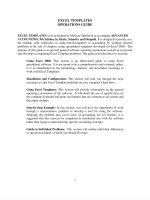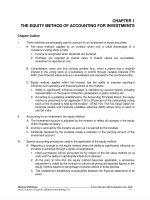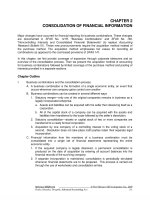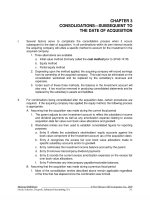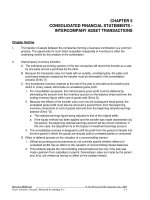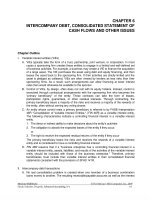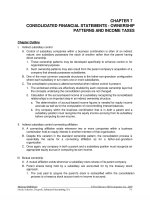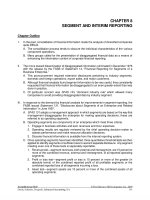Solution manual inernmediate accounting 9e by nicolai ch01
Bạn đang xem bản rút gọn của tài liệu. Xem và tải ngay bản đầy đủ của tài liệu tại đây (182.95 KB, 14 trang )
To download more slides, ebook, solutions and test bank, visit
CHAPTER 1
THE ENVIRONMENT OF FINANCIAL REPORTING
CONTENT ANALYSIS OF CASES
Number
Content
Time Range
(minutes)
C1-1
Pronouncements. Matching a list of descriptive statements
with a list of pronouncements establishing or related to
generally accepted accounting principles.
C1-2
Accounting Organizations. Matching of a list of descriptive
statements with a list of abbreviations of accounting
organizations. Identify complete name of each organization.
10-15
C1-3
History of Establishment of GAAP. Discuss CAP, APB, FASB, and
related pronouncements.
15-30
C1-4
(AICPA adapted). Accounting Principles. Define accounting
principles. Discuss sources of GAAP.
10-20
C1-5
(CMA adapted). Standard Setting. Describe why there is
political action and social involvement in the standard setting
process.
10-20
C1-6
Organization of the FASB. Summarize the structure of the FASB,
its documents (GAAP pronouncements), and its operating
procedures.
10-20
C1-7
GAAP and the AICPA. Summarize the GAAP-related
documents published by the AICPA.
C1-8
Code of Professional Conduct. Identify, briefly discuss, and
provide examples to illustrate the first five principles of CPC.
10-20
C1-9
GAAP Hierarchy. Define GAAP, indicate where to find GAAP,
and identify which GAAP are more important (hierarchy).
10-20
C1-10
Lobbying the FASB. Discuss pros and cons of lobbying FASB by
interested parties.
5-15
C1-11
Ethical Dilemma. Discuss steps to take in an ethical dilemma
("misplaced" book in library).
10-20
C1-12
Ethical Responsibilities. Discuss steps to take in an ethical
dilemma (cheating by friend on exam).
10-20
1-1
5-10
5-10
To download more slides, ebook, solutions and test bank, visit
ANSWERS TO QUESTIONS
Q1-1
Primary markets are those capital markets where the exchanges of stocks and bonds
are directly between a corporation and investors. Secondary markets are those
where the exchanges are among the investors themselves.
Q1-2
The decision makers, or the users of financial information, can be divided into two
major categories: external users and internal users. These two groups have
somewhat different decision making information needs because of their differing
relationships with the company providing economic information. External users need
information for three basic decisions--whether to buy, to hold, or to sell (or in the case
of creditors, whether to extend credit, maintain the credit relationship, or not extend
credit). These users rely mainly on financial statements in their decision processes.
Internal users (i.e., a company's management) need information to make operating
decisions and may request any type of information they need which the accounting
system is capable of providing.
Q1-3
Financial accounting is the information accumulation, processing, and
communication system designed to satisfy the investment and credit decisionmaking information needs of external users of accounting information. Financial
accounting information is communicated through published financial statements,
and is constrained by the pronouncements of several policy-making groups.
Managerial accounting is the information accumulation, processing, and
communication system designed to meet the decision-making information needs of
internal users. Managerial accounting information is communicated via internal
company reports and is not subject to the policy standards that apply to externally
communicated information. It is constrained by the usefulness of the information
provided for a specific decision and the cost of providing that information.
Q1-4
Financial reporting is the process of communicating financial accounting information
about a company to external users. The primary way a company's financial
accounting information is reported is in its annual report.
Q1-5
The three major financial statements of a company and what they summarize are:
(1) the balance sheet (or statement of financial position) which summarizes the
company's financial position at a given date, (2) the income statement which
summarizes the results of the company's income-producing activities for a period of
time, and (3) the statement of cash flows which summarizes the cash inflows and
cash outflows for a period of time. Many companies also present the statement of
changes in stockholders' equity, which summarizes the changes in each item of
stockholders' equity for a period of time, as a fourth major financial statement.
Q1-6
Generally accepted accounting principles (GAAP) are the guidelines, procedures,
and practices that a company is required to use in recording and reporting the
accounting information in its audited financial statements. The four accounting
bodies that have established generally accepted accounting principles are the
Financial Accounting Standards Board (FASB), Accounting Principles Board (APB),
American Institute of Certified Public Accountants (AICPA), and Securities and
Exchange Commission (SEC).
1-2
To download more slides, ebook, solutions and test bank, visit
Q1-7
There are five categories of GAAP in the hierarchy of generally accepted
accounting principles. The pronouncements included in Category A are FASB
Statements of Financial Accounting Standards and Interpretations, APB Opinions,
and AICPA Accounting Research Bulletins (as well as SEC Regulation S-X and
Financial Reporting Releases for companies that file with the SEC).
Q1-8
The CAP was the Committee on Accounting Procedure. This group was given the
authority to issue pronouncements on accounting procedures and practice. These
pronouncements were published as Accounting Research Bulletins. The CAP was
replaced by the APB in 1959.
The APB was the Accounting Principles Board. It was formed as an attempt to create
a policy-making body whose rules would be binding rather than optional. The
pronouncements of the APB were termed Opinions of the Accounting Principles
Board. The APB was phased out and replaced in 1973 by the FASB.
The FASB is the Financial Accounting Standards Board. This Board was formed upon
the recommendations of the Wheat Committee. The FASB issues four types of
documents which constitute generally accepted accounting principles: Statements
of Financial Accounting Standards, Interpretations, Technical Bulletins, and
Statements of Financial Accounting Concepts.
Q1-9
Before issuing a Statement of Concepts or Standards, the FASB generally completes a
multistage process as follows:
(1)
(2)
(3)
(4)
(5)
(6)
(7)
(8)
(9)
(10)
identifies topic
appoints task force
conducts research
issues Discussion Memorandum or Invitation to Comment
holds public hearings
deliberates on findings
issues Exposure Draft
holds public hearings
modifies Exposure Draft
votes
After a 4-3 positive majority vote is attained, the Statement is issued.
Q1-10
The FASB issues four types of pronouncements:
1.
Statements of Financial Accounting Standards. These pronouncements are
releases indicating the methods and procedures required on specific
accounting issues.
2.
Interpretations. These pronouncements provide clarifications of conflicting or
unclear issues relating to previously issued FASB Statements, APB Opinions, or
Accounting Research Bulletins.
3.
Technical Bulletins. These pronouncements are issued by the staff of the FASB
to provide guidance on accounting and reporting problems related to
Statements of Standards or Interpretations.
1-3
To download more slides, ebook, solutions and test bank, visit
Q1-10
(continued)
4.
Statements of Financial Accounting Concepts. These pronouncements are a
series establishing a theoretical foundation upon which to base financial
accounting and reporting standards. They are the output of the FASB's
"conceptual framework" project.
Q1-11
The organizations other than the FASB that have had an impact on the
development of generally accepted accounting principles are the: (1) Securities'
and Exchange Commission, (2) American Institute of Certified Public Accountants,
(3) FASB Emerging Issues Task Force, (4) Cost Accounting Standards Board,
(5) Internal Revenue Service, (6) American Accounting Association, (7) International
Accounting Standards Committee, (8) Governmental Accounting Standards Board,
and (9) G4 + 1.
Q1-12
The IASB is the International Accounting Standards Board. The IASB has 12 full-time
members (and 2 part-time members) from various countries. It issues International
Accounting Standards. To do so, its operating procedures include study of the topic,
issuance of an Exposure Draft, evaluation of comments, and consideration of a
revised draft. If approved by at least 8 members of the IASB, the International
Accounting Standard is issued.
Q1-13
The professional organizations that play an important role in the accounting
standard-setting process include the: (1) Financial Executives Institute, (2) Institute of
Management Accountants, and (3) Association for Investment Management and
Research.
Q1-14
The Code of Professional Conduct is a document published by the AICPA to help
guide members in public practice, industry, government, and education in
performing their responsibilities in an ethical and professional manner. The six areas
covered by the Principles include: (1) responsibilities, (2) public interest, (3) integrity,
(4) objectivity and independence, (5) due care, and (6) scope and nature of
services.
Q1-15
The steps a person should follow to determine whether an action is ethical include:
(1) gathering the facts (e.g., who are the "stakeholders," what are my
responsibilities); (2) asking whether the action is acceptable according to three
ethical criteria, (a) utility: does the action optimize the satisfactions of all
stakeholders? (b) rights: does the action respect the rights of all individuals, and (c)
justice: is the action fair and just?; (3) considering whether there are any
"overwhelming factors" such as conflicts between criteria that may justify
disregarding one or more of the ethical criteria; and (4) deciding whether the
action is ethical based on an evaluation of the applicable ethical criteria.
Q1-16
Creative thinking is the process of finding new relationships or ideas among items of
information that potentially can be used to solve a problem. It involves using
imagination and insight in order to view issues in a different light.
A creative thinker may be described as being insightful, intuitive, imaginative,
sensitive, flexible, original, adaptable, and tolerant of ambiguity.
1-4
To download more slides, ebook, solutions and test bank, visit
Q1-17
Critical thinking is the process of testing new relationships or ideas in order to
determine how well they will work. It involves the use of inductive or deductive
reasoning to analyze an issue in a logical manner.
A critical thinker may be described as being objective, independent, analytical,
logical, rational, able to synthesize, consistent, and organized.
ANSWERS TO CASES
C1-1
E
C
1.
2.
C
G
A
D
J
H
I
F
B
E
K
L
1.
2.
3.
4.
5.
6.
7.
8.
9.
10.
11.
12.
B
D
3.
4.
F
A
5.
6.
C1-2
Committee on Accounting Procedure (CAP)
Cost Accounting Standards Board (CASB)
Internal Revenue Service (IRS)
International Accounting Standards Board (IASB)
Governmental Accounting Standards Board (GASB)
Financial Accounting Standards Board (FASB)
American Accounting Association (AAA)
Financial Accounting Standards Advisory Council (FASAC)
Accounting Principles Board (APB)
Securities and Exchange Commission (SEC)
American Institute of Certified Public Accountants (AICPA)
Emerging Issues Task Force (EITF)
C1-3
Three organizations primarily have been responsible for the establishment of generally
accepted accounting principles in the private sector. These organizations are the
Committee on Accounting Procedure (CAP), the Accounting Principles Board (APB), and
the Financial Accounting Standards Board (FASB).
In 1938, the AICPA formed the CAP. This group was responsible for issuing pronouncements
to narrow the differences in accounting procedures and practice. These pronouncements
were published as Accounting Research Bulletins. From the CAP's inception until 1953, it
issued 42 Accounting Research Bulletins, and in 1953 these pronouncements were
reviewed and codified into Accounting Research Bulletin No. 43. The CAP subsequently
issued eight more Accounting Research Bulletins, ending with No. 51. The CAP was
replaced by the APB in 1959, but all Accounting Research Bulletins still constitute generally
accepted accounting principles unless specifically superseded or amended by other
authoritative bodies.
1-5
To download more slides, ebook, solutions and test bank, visit
C1-3 (continued)
In 1959, the APB was formed by the AICPA as an attempt to (1) alleviate the criticism of the
methods of formulating accounting principles, and (2) create a policy-making body whose
rules would be binding rather than optional. The pronouncements of the APB were termed
Opinions of the Accounting Principles Board, and ultimately 31 of these Opinions were
issued. All APB Opinions are sources of generally accepted accounting principles, unless
specifically amended or rescinded. Many of these Opinions were based upon Accounting
Research Studies which were written by individuals commissioned by the APB.
By the late 1960s criticism again arose about the development of accounting principles.
This criticism centered on independence, representation, and response time. As a result,
the AICPA appointed the Wheat Committee which recommended that the APB be
abolished and that a new full-time body be established.
Thus, the APB was phased out and replaced in 1973 by the FASB. Appointees to the FASB
are full-time members with no other organizational ties and are selected to represent a
wider cross section of interests. The FASB issues four types of pronouncements: Statements
of Financial Accounting Standards, Interpretations, Technical Bulletins, and Statements of
Financial Accounting Concepts.
Statements of Financial Accounting Standards are releases indicating the methods and
procedures required on specific accounting issues. Interpretations provide clarification of
conflicting or unclear issues relating to previously issued FASB Statements of Standards, APB
Opinions, or Accounting Research Bulletins. Technical Bulletins are issued by the staff of the
FASB to provide guidance on accounting and reporting problems related to Statements of
Standards or Interpretations. Statements of Financial Accounting Concepts are a series
establishing a theoretical foundation upon which to base financial accounting and
reporting standards. They are the output of the FASB's "conceptual framework" project. All
of these pronouncements are sources of generally accepted accounting principles.
C1-4 (AICPA adapted solution)
1.
The term "accounting principles" in the auditor's report includes not only accounting
principles but also practices and the methods of applying them. Though the term quite
naturally emphasizes the primary or fundamental character of some principles, it includes
general rules adopted or professed as guides to action in practice. The term does not
connote, however, rules from which there can be no deviation. In some cases, the
question is which of several partially relevant principles has determining applicability.
Neither is the term "accounting principles" necessarily synonymous with accounting theory.
Accounting theory is the broad area of inquiry devoted to the definition of objectives to
be served by accounting, the development and elaboration of relevant concepts, the
promotion of consistency through logic, the elimination of faulty reasoning, and the
evaluation of accounting practice.
2.
Generally accepted accounting principles are those principles (whether or not they have
only limited usage) that have substantial authoritative support. Whether a given principle
has authoritative support is a question of fact and a matter of judgment. The CPA is
responsible for collecting the available evidence of authoritative support and judging
whether it is sufficient to bring the practice within the bounds of generally accepted
accounting practices.
1-6
To download more slides, ebook, solutions and test bank, visit
C1-4 (continued)
2. (continued)
Pronouncements of the FASB, APB, AICPA, and SEC, if there are any on the subject in
question, would be given greater weight than other single sources. Pronouncements of
the FASB, APB, and AICPA constitute substantial authoritative support, and the evidence
would tend to be conclusive if the SEC has issued an affirmative opinion on the same
subject. These pronouncements include FASB Statements of Standards and Interpretations,
APB Opinions, AICPA Accounting Research Bulletins, and SEC Regulation S-X and Financial
Reporting Releases for companies that file with the SEC. However, substantial authoritative
support also can exist for accounting principles in other pronouncements.
Other evidence of authoritative support may be found in the FASB's Technical Bulletins,
Questions and Answers, and Statements of Concepts, the AICPA's Interpretations, Audit
Guides, Accounting Guides, Statements of Position, Issue Papers, Technical Practice Aids,
and, Practice Bulletins, and the FASB EITF Consensus Positions. The affirmative opinions of
practitioners and academicians in articles, textbooks, and expert testimony may also
provide evidence. Similarly, the views of stock exchanges, commercial and investment
bankers, and regulatory commissions influence the general acceptance of accounting
principles and hence are considered in determining whether an accounting principle has
substantial authoritative support. Business practice also is a source of evidence. Finally,
because they influence business practice, the tax code and state laws are also sources of
evidence.
C1-5 (CMA adapted)
Financial accounting standards inspire or encourage political action and social
involvement during the standard setting process because the effects of accounting
standards are wide-ranging and impact many varying groups. The setting of accounting
standards is a social decision and the user groups play a significant role and have
considerable influence.
The economic consequences of financial accounting standards inspire special interest
groups to become vocal and critical when standards are being formulated. The reporting
of financial information impacts organizations' financial statements and the wealth and
decision-making of organizations in differing ways. In addition, some important
components of financial information, e.g., net income, cannot be verified empirically. The
way financial data is presented impacts user perceptions and influences investment
decisions. User groups may want particular economic events accounted for in particular
ways, and are willing to fight for what they want.
The formulation of accounting standards has political roots in the Securities and Exchange
Acts of 1933 and 1934. Although the SEC was vested with complete authority to define
and formulate accounting standards, it has, for the most part, delegated this authority to
the private sector. The SEC supports the FASB in this endeavor and encourages its "due
process" system of standard setting. Financial accounting standards issued are considered
to be "generally accepted accounting principles" and, as such, they must be followed in
the preparation of financial statements. Public accounting firms and independent CPAs
are prohibited from expressing opinions on financial statements unless they conform to
these principles. Therefore, the formulation of standards is of vital interest to these groups
as well as the client organizations responsible for the financial statements.
1-7
To download more slides, ebook, solutions and test bank, visit
C1-6
The Financial Accounting Foundation is the parent organization of the FASB. It is governed by a
16-member Board of Trustees appointed from the memberships of nine organizations (the AICPA,
Financial Executives Institute, Institute of Management Accountants, Association for Investment
Management and Research, American Accounting Association, Securities Industry Association,
Government Finance Officers Association, Comptrollers and Treasurers, and National Association
of State Auditors, Controllers, and Treasurers) interested in the formulation of accounting
principles. The primary responsibilities of the Financial Accounting Foundation are to provide
general oversight to its operations and appoint the members of the Financial Accounting
Standards Advisory Council (FASAC) and the FASB. The FASAC consists of about 33 influential
members; it is responsible for advising the FASB about major policy issues, the priority of topics,
the selection of task forces, the suitability of tentative decisions, and other matters.
There are seven members of the FASB. Appointees to the FASB are full-time, fully paid members
with no other organizational ties and are selected to represent a wide cross-section of interests.
Each Board member is required to have a knowledge of accounting, finance, and business;
high intelligence, integrity, and discipline; and a concern for the public interest regarding
financial reporting. Currently, the FASB includes (1) five members who are CPAs and who have
been in public practice, and (2) two members from other areas related to accounting (e.g.,
academia and industry). The FASB is responsible for identifying financial accounting issues,
conducting research to address these issues, and resolving them. The FASB is supported by a
research and technical staff that performs numerous functions such as researching issues,
communicating with constituents, and drafting preliminary findings. The administrative staff
assists the FASB by handling library, publications, personnel, and other activities.
The FASB issues several types of pronouncements:
1.
Statements of Financial Accounting Standards. These pronouncements establish generally
accepted accounting principles. They are releases indicating the methods and
procedures required on specific accounting issues.
2.
Interpretations. These pronouncements provide clarification of conflicting or unclear issues
relating to previously issued FASB Statements of Standards, APB Opinions, or Accounting
Research Bulletins. Interpretations also establish or clarify generally accepted accounting
principles.
3.
Technical Bulletins. These pronouncements are issued by the staff of the FASB to provide
guidance on accounting and reporting problems related to Statements of Standards or
Interpretations. The guidance may clarify, explain, or elaborate upon an underlying
standard.
4.
Statements of Financial Accounting Concepts. These pronouncements establish a
theoretical foundation upon which to base financial accounting and reporting standards.
These Statements are the output of the FASB's "Conceptual Framework" project.
5.
Other Pronouncements. On a major topic, the FASB staff may also issue a Guide for
Implementation which is in the form of questions and answers (referred to as FASB Q's and
A's).
1-8
To download more slides, ebook, solutions and test bank, visit
C1-6 (continued)
Before issuing a statement of concepts or standards, the FASB generally completes a multistage
process, although the sequence and numbers of steps may vary. Initially, a topic or project is
identified and placed on the FASB's agenda. This topic may be the result of suggestions from
the FASAC, the accounting profession, industry, or other interested parties. On major issues a
Task Force may be appointed to advise and consult with the FASB's Research and Technical
Staff on such matters as the scope of the project and the nature and extent of additional
research. The Staff then conducts any research specifically related to the project.
A Discussion Memorandum or Invitation to Comment, which outlines the research related to the
issues, is then usually published and a public comment period is set. During this period, public
hearings, similar to those conducted by Congress, may be held. The intent is to receive
information from and views of interested individuals and organizations on the issues. Many
parties submit written comments ("position papers") or make oral presentations. These parties
include representatives of CPA firms and interested corporations, security analysts, members of
professional accounting associations, and academicians, to name a few. After deliberating on
the views expressed and information collected, the FASB issues an Exposure Draft of the
proposed Statement. Interested parties generally have 30-90 days to provide written comments
of reaction. On major issues, more public hearings may be held. Sometimes, "field tests" of the
proposed standards are conducted with selected companies to evaluate implementation
issues. A modified draft is prepared, if necessary, and brought to the FASB for a final vote. After
4 to 3 positive vote is attained, the Statement is issued.
C1-7
The AICPA publishes numerous documents that may be considered as sources of GAAP. For
example, Industry Audit Guides and Industry Accounting Guides are publications designed to
assist independent auditors in examining and reporting on financial statements of various types
of entities in specialized industries. Statements of Position are publications intended to influence
the development of financial accounting principles that best serve the public interest. Practice
Bulletins are publications that provide guidance on specific technical issues. Issue Papers help
the FASB identify accounting areas that need to be addressed and clarified.
The AICPA also annually publishes Accounting Trends and Techniques which provides a study of
the latest accounting practices and trends, as identified from a survey of 600 published annual
reports. The AICPA has also issued numerous Accounting Interpretations to provide timely
guidance on accounting issues without the formal procedures necessary for an APB Opinion.
C1-8
The first five principles of the AICPA's Code of Professional Conduct are as follows:
1.
Responsibilities: In carrying out their responsibilities as professionals, members should
exercise sensitive professional and moral judgments in all their activities. For example,
when a member chooses a depreciation method, she must carefully analyze each
alternative based upon well-defined criteria before making a final choice.
2.
The Public Interest: Members should accept the obligation to act in a way that will serve
the public interest, honor the public trust, and demonstrate a commitment to
professionalism. When a member refuses to ignore internal control deficiencies in a
company with publicly traded stock, but instead enumerates these deficiencies in the
Auditor's report, she is adhering to the public interest principle.
1-9
To download more slides, ebook, solutions and test bank, visit
C1-8 (continued)
3.
Integrity: To maintain and broaden public confidence, members should perform all
professional responsibilities with the highest sense of integrity. For example, a member who
carefully and conscientiously performs each step of an audit without skipping those steps
that are tedious or of less interest is exercising the integrity principle.
4.
Objectivity and Independence: A member should maintain objectivity and be free from
conflicts of interest in discharging professional responsibilities. A member in public practice
should be independent in fact and appearance when providing auditing and other
attestation services. For example, a member who declines to audit the financial
statements of the company for which his father is a marketing vice president is adhering to
this principle.
5.
Due Care: A member should observe the profession's technical and ethical standards,
strive continually to improve competence and the quality of standards, strive continually to
improve competence and the quality of services, and discharge professional responsibility
to the best of the member's ability. When a member reads current accounting literature
and strives to employ current principles and procedures, she is exercising due care.
C1-9
The "rules" for financial accounting are called generally accepted accounting principles.
Generally accepted accounting principles (GAAP) are the guidelines, procedures, and
practices that a company is required to use in recording and reporting the accounting
information in its audited financial statements. GAAP define accepted accounting
practices at a particular time and provide a standard by which to report financial results.
They are like laws that must be followed in financial reporting.
There are several accounting policy-making bodies that have established GAAP, including
the Financial Accounting Standards Board (FASB), Accounting Principles Board (APB),
American Institute of Certified Public Accountants (AICPA), and Securities and Exchange
Commission (SEC). There is no single document that includes all the accounting standards.
[However, there are electronic data bases, such as the FASB Financial Accounting
Research System (FARS) that include most accounting standards.] In addition, the FASB
standards are published each year as part of the FASB's Accounting Standards series.
These standards are included in two-volume set entitled Original Pronouncements which
contains each major pronouncement as of its date of publication. Another two-volume
set entitled Current Text (General Standards and Industry Standards), is a topical
integration of currently effective accounting and reporting standards as of its date of
publication. The AICPA and SEC standards are also published on an annual basis.
1-10
To download more slides, ebook, solutions and test bank, visit
C1-9 (continued)
The following is a "hierarchy" of five categories of GAAP and the authoritative sources
applicable to each category for companies:
Categories
Authoritative Sources
(Pronouncements)
FASB Statements of Financial Accounting
Standards and Interpretations, APB Opinions,
and CAP (AICPA) Accounting Research Bulletins
(as well as SEC Regulation S-X and Financial
Reporting Releases for companies that file with
the SEC)
A.
Pronouncements of authoritative
bodies (FASB, APB, CAP, SEC)
B.
Pronouncements of bodies of expert
accountants that have been
exposed for public comment
FASB Technical Bulletins, AICPA Industry Audit
and Accounting Guides, and AICPA Statements
of Position
C.
Pronouncements of bodies of expert
accountants that have not been
exposed for public comment
FASB Emerging Issues Task Force Consensus
Positions and AICPA Practice Bulletins
D.
Widely accepted practices and
pronouncements representing
prevalent practice in a particular
industry or applications to specific
circumstances
AICPA Accounting Interpretations, FASB Q's and
A's, and AICPA Accounting Trends and
Techniques
E.
Other accounting literature
For instance, FASB Statements of Financial
Accounting Concepts, APB Statements, AICPA
Issue Papers, AICPA Technical Practice Aids,
and accounting texts and articles
These categories are listed in descending order of importance, with Category A as the most
important. Accountants must follow the GAAP established by the pronouncements applicable
to this category unless, in unusual circumstances, they result in misleading financial statements.
In these circumstances or in situations where the accounting for a transaction or event is not
specified by a pronouncement in category A, then pronouncements in categories B through D
may be used to identify GAAP. Generally, pronouncements in category B take precedence
over those in category C which, in turn, take precedence over those in category D. When none
of the pronouncements in categories A through D are applicable, then the accountant may
consider other accounting literature (category E).
1-11
To download more slides, ebook, solutions and test bank, visit
C1-10
On balance, most people would agree that it is a good idea for the FASB to allow written
comments and oral presentations in which interested parties can lobby for a particular ruling.
However, there are both pros and cons to allowing interested parties to provide input to its
deliberation process. They include:
Advantages
Enables FASB to get input from different perspectives
Provides users a forum to express concerns
Provides preparers a forum to express concerns
Provides auditors a forum to express concerns
Overcomes criticism of failing to listen to constituencies
Allows for consideration of views of all interested parties
Rulings appear more fair to all constituencies
Rulings consider the costs and benefits of implementation
Standards are established that are the most acceptable
Allows for clarification of rules
Allows for corrections of any errors
Allows for consideration of implementation issues
Disadvantages
Rulings sometimes appear to be biased in favor of certain user group
Rulings sometimes are inconsistent with other Statements of Standards
Rulings sometimes are inconsistent with Statements of Concepts
Rulings sometimes appear illogical
FASB is too slow in establishing standards
Standards are too complex and difficult to implement
C1-11
Note to Instructor: Listed below are some possible findings that students may discuss at each
step in the moral reasoning process:
I.
Gather facts: (A) What has occurred? (1) there is only one copy of the needed book,
(2) everyone in my class is required to use the book to write a report, (3) the book has
been intentionally misfiled. (B) Who are the stakeholders? (1) me, (2) classmate who
has misfiled the book, (3) other member of the class, (4) the professor, (5) other students
wanting to use the book, (6) library staff. (C) What are my responsibilities? (1) to write a
report (2) to be socially responsible.
1-12
To download more slides, ebook, solutions and test bank, visit
C1-11 (continued)
II.
Ask whether the action (my classmate misfiling the book) is acceptable according to
three ethical criteria: (A) Utility: Does the action optimize the satisfactions of all
stakeholders? (1) the classmate who misfiled the book can satisfactorily use the book
without having to wait his turn, (2) I am unable to use the book to finish my report,
(3) the rest of the class cannot use the book to finish their reports, (4) the professor
cannot collect the assignment on the regularly scheduled due date, (5) others wanting
to use the book cannot find it, (6) library staff will be forced to search for the book.
(B) Rights: Does the action respect the rights of all? (1) the classmate who misfiled the
book has the right to use the book, (2) other members of the class as well as other
students have the right to use the book, but cannot if it is misfiled, (3) the professor
cannot exercise his/her right to set due dates and expect them to be adhered to,
(4) the library staff cannot effectively and efficiently perform its job. (C) Justice: Is the
act fair and just? (1) purposely preventing others from completing an assignment is not
fair, (2) making it difficult for others to find a book is not just, (3) inhibiting the library
staff's ability to perform its job is not fair, (4) forcing the professor to accept late reports is
not just.
III.
Consider whether there are any overwhelming factors affecting criteria: In this situation,
there do not appear to be overwhelming factors but students may bring up issues like:
(1) classmate has full-time job, (2) classmate is disabled, (3) classmate has family (or
other) obligations, (4) library has limited hours.
IV.
Decide what ethical action to take: Students may decide on a number of alternative
courses of action, including: (1) doing nothing, (2) discussing with classmate, (3)
discussing with other students to exert pressure on classmate to refile book, (4) reporting
to professor (in person or anonymously).
C1-12
Note to Instructor: Listed below are some possible findings that students may discuss at each
step in the moral reasoning process:
I.
Gather facts: (A) What has occurred? (1) my friend copied an answer, (2) she
received an A on the test, (3) I received a B on the test, (4) our professor is unaware that
she cheated, (5) I am aware that she cheated. (B) Who are the stakeholders: (1) my
friend who cheated, (2) me, (3) student from whom my friend copied the answer,
(4) our professor, (5) other members of the class, (6) all students in other sections of the
same course, (7) all accounting students at my school who have taken the same class,
(8) all students who will be competing with my friend for jobs, (9) all accountants, (10)
company that hires her.
1-13
To download more slides, ebook, solutions and test bank, visit
C1-12 (continued)
II.
Ask whether the action (my friend's cheating) is acceptable according to three ethical
criteria: (A) Utility: Does the action optimize the satisfaction of all stakeholders? (1) her
copying led to a short-term satisfaction in the form of an A. However, in the long-run,
this A may prove to be harmful to her if she views the A as a reward for cheating and
continues to cheat in the future, (2) my receipt of a lower grade puts her at an unfair
advantage over me, (3) others in the class who received the same grade as her had to
rely on their own effort and intelligence, whereas she was rewarded with the same
grade for relying on someone else's work, (4) others in the class who received a lower
grade than her are at a disadvantage to her even though they may be equally
intelligent, (5) because recruiters compare the grades of all their applicants, she will
appear more qualified because her A will cause her GPA to increase, (6) the professor
may be placed in a position of giving her a higher recommendation than warranted,
(7) her future employer may be depending on higher qualifications than she has.
(B) Rights: Does the action respect the rights of all? (1) my friend forfeited her right to a
good grade by cheating, (2) others in the class had their rights violated because they
can no longer compete fairly, (3) the professor can no longer exercise his/her right to
distribute grades fairly, (4) recruiters cannot exercise their right to use GPA as a
quantitatively reliable guide for selecting employees. (C) Justice: Is the act fair and
just? (1) cheating is not generally accepted as being fair, (2) receiving a better grade
through deceit is not just, (3) having an advantage in recruiting due to dishonesty is not
fair.
III.
Consider whether there are any overwhelming factors between criteria: In this situation,
there do not appear to be overwhelming factors but students may bring up issues like:
(1) friend has full-time job, (2) friend is disabled, (3) friend has family (or other)
obligations, (4) friend was sick before class, (5) friend was an athlete.
IV.
Decide what ethical action to take: Students may decide on a number of alternative
courses of action, including: (1) doing nothing, (2) discussing with friend, (3) discussing
with student from whom friend copied (or other students) to exert pressure on friend to
confess action to professor, (4) reporting to professor (in person or anonymously).
1-14

